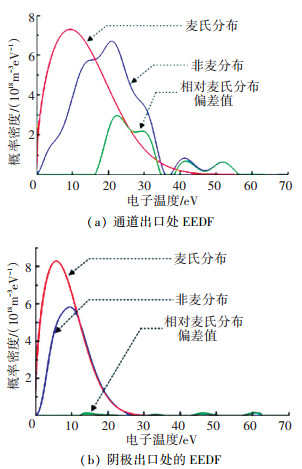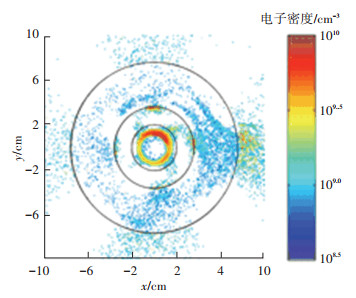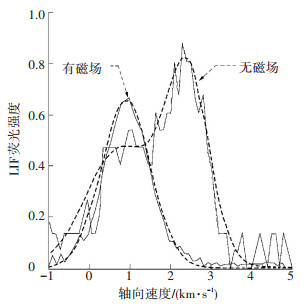霍尔推力器由陶瓷加速通道和外部的空心阴极两部分构成,二者是一直以来研究的重点.加速通道与阴极之间还存在一个区域,负责二者的电荷与能量交换,称为耦合区.近年来发现,该区域内物理过程也会影响整体性能.特别是阴极安装位置和角度,对推力器性能有较显著的影响.已见报的测试结果中,推力增量最大达到25 mN(6 kW推力器),效率增加5%,比冲增量70 s[1].物理层面上,该区域内的电子传导路径、压降形成机理、振荡模式等与霍尔推力器尚未解决的异常电子传导、阴极异常腐蚀等问题有着密切的联系,相关机制需要深入研究.
耦合区早期的研究主要是为了优化阴极安装位置,许多单位做了大量的枚举法试验[1-12],希望得到一个普适性结论.但研究结果表明, 不同的推力器最优安装位置及角度并不相同.例如,有的推力器最优位置在外磁极边缘,最优安装角为平行于推力器轴线[2];有的则在尽可能远处,45°角安装[1];还有的在中间位置[13].此外,还发现了阴极位置和推力偏心[14]、阴极腐蚀[15]和推力器电磁波谱[16-20]等存在复杂关系.从这些非单调的趋势可以看出,阴极的安装位置并不是简单的远近或内置外置的问题,而是与阴极当地的磁场、离子束流如何匹配的问题[21-26].安装位置的优化方法,还是应该回归耦合区E×B放电物理过程的研究.然而,由于以往推力器和阴极在设计时很少关注二者交界区的问题,导致目前耦合区物理盲点较多,许多现象还无法解释.
本文介绍耦合区的研究现状,回顾和分析取得的重要研究结论,总结遇到的主要问题,并对需要继续关注的问题给出建议.
1 霍尔推力器耦合区物理过程分析从几何上划分,耦合区一般是指阴极出口和通道出口之间的等离子体区域.该区域中,阴极发射出的电子束在磁场作用下弯曲,形成从阴极出口连接至内磁极端面上的一条亮线(图 1);同时, 在E×B场中进行漂移,形成一个扇面结构(图 2).该发光扇面是通常所称的等离子体桥,它是电子传导至通道内和羽流下游的主要通道.

|
图 1 等离子体桥亮线 |

|
图 2 等离子体桥扇面 |
与等离子体桥相关的电子轨迹十分复杂,现实的做法是统计电子的分布和波动特性.该区域可归纳出:电子向通道内传导, 羽流中和过程, 等离子体桥电子的E×B漂移以及耦合环境中的阴极放电等4个过程.首先介绍等离子体参数分布,包括电子密度和电子温度的分布,之后简述相关影响因素的研究结果.
1.1 种子电子向通道内传导 1.1.1 参数分布Khartov[27]等发现,电子在阴极出口处密度最高,等效电子温度最低,在靠近通道出口或向羽流下游迁移过程中等效电子温度会逐渐升高.电子能量分布(EEDF)从麦氏分布逐渐变为非麦分布,快电子组分逐渐增加,如图 3所示.

|
图 3 不同位置处的电子温度分布函数[27] |
种子电子的传导过程受振荡、壁面碰撞和阴极位置影响较大. Smith等[28]对近场区电子轨迹进行了蒙特卡洛模拟,结果(表 1)表明,外磁极壁面处碰撞、磁场不对称性和库伦碰撞会增强种子电子向通道内传导.耦合区内可测得的螺旋振荡也有相似的作用,从该模拟可以看出,电子的扩散系数在螺旋振荡算例中有所增加, 但其机理还不明确.有观点认为[29-30],是螺旋振荡所产生的周向电场漂移Eφ×B增强了种子电子的传导.此外,还发现种子电子电流值对阴极位置、角度和发射的电子电流扩散角十分敏感.这些参数微小的调节会引起种子电子电流值剧烈的变化.
| 表 1 种子电子电流影响因素数值模拟结果[28] |
Raitses等[31]发现,种子电子和中和电子的传导过程还与真空背压有关.过去一直认为真空背压主要提供粒子反流.而Raitses认为,背压还影响种子电子传导的阻抗.背压升高,碰撞频率增高,传导阻抗减小,有利于减小耦合电压,提高电压利用率.在其实验中还发现,背压超过某一临界,耦合区内的螺旋振荡会消失.
此外,Alberede等[32]还观察到通道出口空间电势、电子密度跟随羽流离子密度波动而波动的现象. Alberede认为,当离子密度出现波动时,相应的阴极与出口间电势分布会改变,使阴极发射的电子具有不同的作用:离子密度谷值来临时,相应的会有一部分电子作为种子电子向阳极传导;但离子密度峰值来临时,阴极发射的电子主要用于中和这部分离子.
1.2 羽流中和过程 1.2.1 参数分布Alberede的研究[32]引出了一个暗含的问题:种子电子和中和电子是否有交界?Morozov等[33]曾提出“中和机制转换区域”的概念:该区域中离子由被闭环漂移的电子中和转换成被阴极发射的电子中和.但当时并未找到直接的实验证据.
如果假设闭环漂移电子向阳极迁移,而中和电子向羽流迁移,则该转换区域将会是电子电流的分流区域.可以通过分析电子分流过程,来近似表征中和机制的转换过程.
近年有一些实验现象似乎是分流过程的痕迹.首先,Bugrova等[34]与Bacal等[35]的研究表明,通道内与通道外电子净通量方向相反.从电荷守恒角度,需要存在一个电子注入区;从速度场连续性角度,需要存在一个零净通量区.阴极出口区电子的流线分布[36]见图 4.

|
图 4 耦合放电近阴极区825 nm光强分布[36] |
耦合区内阻抗(与阴极负)轴向分布[37]见图 5.由4、5可以看出, 阴极羽流确实发生了分流过程.特别是通道与近场区模拟出的电子流线分布[38](图 6)显示,存在电子通量散度大于零的区域.

|
图 5 等离子体桥轴向阻抗分布[37] |

|
图 6 通道与近场区电子通量分布[38] |
中和过程一直延伸至远场区. Sekerak等[39]所测量的参数分布中,空间电势从出口向外逐渐下降,电子温度逐渐降低;电子数密度显示,羽流会逐渐向中轴线聚拢.此外,羽流中电子具有较强的定向性,宏观速度与离子束流方向基本一致. Bacal[35]认为,阴极中和离子束流过程中会从后者获得能量.
1.2.2 影响因素分析实验测量到近场区存在多种振荡.这些振荡会影响电导特性,从而影响中和过程.例如,1.1.2节已经叙述的电位和电子密度跟随离子浪涌呈周期性变化.除了这种由于低频振荡引起的轴向离子浪涌以外,Knoll等[40]还测量到周向1~10 MHz的螺旋振荡、周向80~100 MHz的螺旋振荡、轴向1~5 MHz离子振荡(图 7),甚至是2.2~2.4 GHz的振荡(图 8)、远场区周向16~28 kHz的螺旋振荡[39, 41].伴随这些振荡,Dannenmayer等[42]测量到EEDF,特别是高能尾部的组分会周期性增减.高能尾部周期性增减对加速通道内的深层次影响还不清楚.

|
α =arctan(kθ/kz), kθ:周向波数, kz轴向波数 图 7 近场区离子电流振荡频率与α角的关系[40] |

|
图 8 近场区离子电流振荡频谱[40] |
WU和Walker等[13]发现,阴极位置对中和过程影响也很大.实验中,测量到推力器羽流电位高于壳体两翼磁感线包络区的电位. Walker认为,中和电子需要跨越两翼的磁感线去中和离子束流,其路径看似与推力器内部无关,但沿程碰撞引起的振荡最终会被耦合进电源中,从而影响推力器性能.因此,阴极在外磁路中的位置会影响中和电子的路径,从而影响放电稳定性.
1.3 等离子体桥电子的E×B漂移 1.3.1 参数分布与霍尔推力器等漂移假设不符,耦合区表现出比较明显的周向不均匀性. Khartov等[27]的实验中,电子温度在周向上不均匀,在阴极通道圆周上的对顶点处电子温度比阴极出口高. Smith[30]的模拟中,电子密度在等离子体桥E×B漂移下游1/4π~1/2π范围内较高(图 9).与之对应的是该圆周角范围内较低的离子通量[43](图 10),以及朝向阴极的离子速度分量[14].目前,尚不清楚这种周向不对称性会对霍尔推力器放电过程产生哪些深层次的影响.

|
(阴极布置在(x=0 cm, y=10 cm)处悬浮于纸面上方2 cm, 推力器为采用4根导磁柱的SPT结构) 图 9 通道出口(r, φ)平面电子密度的分布[30] |

|
图 10 (0, π)圆周角内羽流离子通量分布[43] |
E×B漂移过程与很多参数有关.首先,耦合区的周向不对称性与阴极流量有关,流量较大时,偏阴极一侧离子通量较大[36](图 11).其次,通道出口处电子密度的周向对称性受放电电压影响较大,通道出口处的单探针测量表明,电压升高,近阴极区电子温度升高,且周向更不均匀[27].此外,周向对称性与励磁电流的正反有关,推力器励磁电流反向前后,可以肉眼观察到等离子体桥扇面也反向做E×B漂移,与此同时通道束流也一定程度上发生了偏斜[37](图 12).最后需要指出,周向不均匀性不单指等离子体桥漂移扇面引起的不对称,还包括由于振荡引起的密度与电位的周向块区(图 13).实验中这些振荡的色散关系比较杂乱,已知的驱动因素有电离[44]、磁场梯度[45],甚至是电子混合过程[33],且仍在不断挖掘.

|
图 11 耦合区阴极所在(r, z)平面内525 nm光强分布[36] |

|
图 12 磁场反向前后羽流离子电流径向分布[37] |

|
图 13 推力器通道内电位周向分布模拟结果[38] |
实验表明阴极放电特性受耦合环境(如磁场、电场和背压等)影响较大.已有研究结果包括:磁场降低了三极管放电的电压(图 14),改变了内腔放电气压[25](图 15),将阴极电势降内的电位振荡幅值减小了一个数量级[23],并降低了阴极羽流内离子的速度[46](图 16).这些现象充分体现了有磁场的阴极放电特性与三极管放电的差异性.阴极外部供气后推力器推力增大[10](图 17),又说明近阴极区物理过程的干预会对下游产生影响.因此,在研究耦合区内物理过程时,掌握耦合场中阴极电子源的特性是必要的.

|
图 14 轴向磁场强度对阴极放电电压的影响[25] |

|
图 15 轴向磁场强度对阴极内腔气压的影响[25] |

|
图 16 磁场对阴极出口区离子速度分布的影响[46] |

|
图 17 阴极出口喷冷气对推力器推力的影响[10] |
本文介绍了霍尔推力器-阴极耦合区的研究现状,总结了耦合区参数分布特点和已发现的影响因素.耦合区有如下几个特点:
1) 轴不对称性.把三维物理过程视为轴对称是霍尔推力器的一个基础性假设.耦合区可能是唯一一个不满足该假设的区域.
2) 近壁面过程的贡献较小.与加速通道和阴极不同,耦合区几乎是一个开放的空间,缺乏壁面约束,因此相对于等离子体-壁面相互作用,一些不稳定性的影响更加突出[47].
3) 动力学特征.电子从阴极发射之后,经历了由麦氏分布、各向同性向非麦分布、各向异性过渡的过程,导致使用普通的流体或是粒子方法描述耦合区都有可能失准,正如喷气推进实验室在近阴极区遇到的困难一样[48-50].
3 展望 3.1 物理层面耦合区的研究已经进入到了电子传导层面,但耦合区的特殊性导致该区域很难直接套用加速通道内部或空心阴极内部的成熟结论.又由于以往不太重视这种交界区的问题,导致许多现象还缺乏合理的解释.针对已发现的现象,但不仅限于这些现象,建议在物理层面上,未来研究应关注如下问题:
1) 阴极电子源在耦合环境中的特性.阴极处于电子传导的源头,它下游物理过程的描述需要阴极特性作为铺垫.以往阴极设计不考虑这些问题,相关机理认识还很有限.
2) 耦合区内振荡的成因及影响.以往研究振荡问题多集中在加速通道内部,对出口以外的振荡问题,例如近阴极区振荡[51]、微波辐射[30, 33]、对整体动力学的影响[32, 46]等问题,还没有深入讨论过.
3) 周向不对称性的影响.漂移扇面的周向不对称性可能引发的连锁反应,例如对加速通道内部对称性的影响以及对振荡的贡献[52]等,还未评估过.
4) 适应耦合区的研究手段.包含非接触式诊断方法、瞬态测量方法以及适合耦合区特点的模型和算法.
3.2 工程层面在实际工程应用层面上,建议留意如下问题:
1) 大型推力器的耦合区优化.大推力器加速通道和阴极的关键尺寸、工作特性和主导效应与中小推力器存在较大差异[53-54],可能需要单独研究大型推力器的耦合问题.
2) 寿命后期耦合问题.寿命后期加速通道与阴极工作特性的漂移,可能在后期伴生出新的物理效应[55-56],相关的认识有助于进一步了解寿命演化过程.
3) 微波辐射问题.了解耦合区微波辐射的发射特性,有助于减小霍尔推力器对航天器整体的通讯干扰.
| [1] |
MCDONALD M S, GALLIMORE A D. Cathode position and orientation effects on cathode coupling in a 6-kW hall thruster[C/OL]. [2015-11-23]. http://erps.spacegrant.org/uploads/images/images/iepc_articledownload_1988-2007/2009index/IEPC-2009-113.pdf.
|
| [2] |
TILLEY D L, de GRYS K H, MYERS R M. Hall thruster-cathode coupling[C]//Proceedings of 35th Joint Propulsion Conference & Exhibit. Reston: AIAA, 1999: 1-10.
|
| [3] |
CARPENTER C. Comparison of on-orbit and ground based hollow cathode operation[C]//Proceedings of 38th Joint Propulsion Conference & Exhibit. Reston: AIAA, 2002: 1-11.
|
| [4] |
BEAL B E, GALLIMORE A D. Effects of cathode configuration on hall thruster cluster plume properties[J]. Journal of Propulsion and Power, 2007, 23(4): 836-844. DOI:10.2514/1.24636 |
| [5] |
SOMMERVILLE J D, KING L B. Effect of cathode position on hall-effect thruster performance and cathode coupling voltage[C]//Proceedings of 43rd Joint Propulsion Conference & Exhibit. Reston: AIAA, 2007: 1-11.
|
| [6] |
SOMMERVILLE J D, KING L B. Effect of cathode position on hall-effect thruster performance and near-fieldplume properties[C]//44th Joint Propulsion Conference & Exhibit. Reston: AIAA, 2008: 1-20.
|
| [7] |
SOMMERVILLE J D, KING L B. Hall-effect thruster-cathode coupling part I: efficiency improvements from an extended outer pole[C]//45th Joint Propulsion Conference & Exhibit. Reston: AIAA, 2009: 1-14.
|
| [8] |
SOMMERVILLE J D, KING L B. Hall-effect thruster-cathode coupling, part Ⅱ:ion beam and near-field plume[J]. Journal of Propulsion and Power, 2011, 27(4): 754-767. DOI:10.2514/1.50124 |
| [9] |
ALBAREDE L, LAGO V, LASGORCEIX P, et al. Correlation between hollow cathode operating conditions and hall thruster (SPT100-ML) performances[C]//Proceedings of 38th Propulsion Conference & Exhibit. Reston: AIAA, 2002: 1-12.
|
| [10] |
KAMHAWI H, HUANG W, HAAG T. Investigation of the effects of cathode flow fraction and position on the performance and operation of the high voltage hall accelerator[C]//Proceedings of 50th Joint Propulsion Conference. Reston: AIAA, 2014: 1-13.
|
| [11] |
张岩, 康小录. 空心阴极对霍尔推力器性能的影响研究[C]//第八届中国电推进技术学术研讨会论文集. 北京: 中国宇航学会, 2012: 198-203.
|
| [12] |
MIYASAKA T, ASATO K, FURUTA D, et al. Characteristics of side by side operation of hall thruster[C/OL]. [2015-11-23]. http://erps.spacegrant.org/uploads/images/2015Presentations/IEPC-2015-70_ISTS-2015-b-70.pdf.
|
| [13] |
WALKER J A, FRIEMAN J D, WALKER M, et al. Hall effect thruster electrical interaction with a conductive vacuum chamber[C]//Proceedings of 50th Joint Propulsion Conference. Reston: AIAA, 2014: DOI: 10.2514/6.2014-3817.
|
| [14] |
BOURGEOIS G, MAZOUFFRE S, SADEGHI N. Unexpected transverse velocity component of Xe+ ions near the exit plane of a hall thruster[J]. Physics of Plasmas, 2010, 17(113502): 1-7. DOI:10.1063/1.3507308 |
| [15] |
KIM V, ARKHIPOV A, BISHAEV A, et al. Investigation of the "back" and "radial" ion flows in the vicinity of the stationary plasma thruster exit plane[C/OL]. [2015-11-23]. http://erps.spacegrant.org/uploads/images/2015Presentations/IEPC-2015-247_ISTS-2015-b-247.pdf.
|
| [16] |
LOYAN A, TITOV M, RYBALOV O, et al. Middle power hall effect thrusters with centrally located cathode[C/OL]. [2015-11-23]. http://erps.spacegrant.org/uploads/images/images/iepc_articledownload_1988-2007/2013index/oi1pcpmn.pdf
|
| [17] |
JAMESON K K. Investigations on hollow cathode effects on total thruster efficiency of a 6-kW hall thruster[D]. Los Angeles: University of California Los Angeles, 2009.
|
| [18] |
JAMESON K K, GOEBEL D M, HOFER R, et al. Cathode coupling in hall thrusters[C/OL]. (2007-09-05)[2015-11-23]. http://erps.spacegrant.org/uploads/images/images/iepc_articledownload_1988-2007/2007index/IEPC-2007-278.pdf.
|
| [19] |
GOEBEL D M, JAMESON KK, HOFER R. Hall thruster cathode flow impact on coupling voltage and cathode life[J]. Journal of Propulsion and Power, 2012, 28(2): 355-363. DOI:10.2514/1.B34275 |
| [20] |
BEITING E J, COX W A, DIAMANT K D, et al. Busek BHT-1500 external vs. center cathode EMC study[C/OL]. [2015-11-23]. http://erps.spacegrant.org/uploads/images/015Presentations/EPC-2015-124_ISTS-2015-b-124.pdf.
|
| [21] |
SOMMERVILLE J D. Hall-effect thruster-cathode coupling: the effect of cathode position and magnetic field topology[D]. Hughton: Michigan Technical University, 2009.
|
| [22] |
孟天航, 宁中喜, 于达仁. 电推进空心阴极实验的磁场环境等效[C]//中国第十届电推进学术研讨会论文集. 上海: 中国宇航学会, 2014: 1-4.
|
| [23] |
FARNELL C, WILLIAMS J D, FARNELL C. Comparison of hollow cathode discharge plasma configurations[C/OL]. [2015-11-23]. http://erps.spacegrant.org/uploads/images/images/iepc_articledownload_1988-2007/2009index/IEPC-2009-016.pdf.
|
| [24] |
GOEBEL D M, JAMESON KK, KATZ I, et al. Potential fluctuations and energetic ion production in hollow cathode discharges[J]. Physics of Plasmas, 2007, 14(103508): 1-16. DOI:10.1063/1.2784460 |
| [25] |
MENG Tianhang, NING Zhongxi, YU Daren. Influence of background magnetic field on hollow cathode discharge characteristics[C/OL]. [2015-11-23]. http://erps.spacegrant.org/uploads/images/2015Presentations/IEPC-2015-77_ISTS-2015-b-77.pdf.
|
| [26] |
GEORGIN M, DUROT C, GALLIMORE A D. Preliminary measurements of time resolved ion velocity distributions near a hollow cathode[C/OL]. [2015-11-23]. http://erps.spacegrant.org/uploads/images/2015Presentations/IEPC-2015-106_ISTS-2015-b-106.pdf.
|
| [27] |
KHARTOV S, NAZARENKO I P, PERESLAVTSEV A A. Plasma parameters investigation in the near cathode zone of the SPT discharge[C/OL]. (2007-09-05)[2015-11-23]. http://erps.spacegrant.org/uploads/images/images/iepc_articledownload_1988-2007/2007index/IEPC-2007-006.pdf.
|
| [28] |
SMITH A W, CAPPELLI M A. On the role of fluctuations, cathode placement, and collisions on the transport of electrons in the near-field of hall thrusters[J]. Physics of Plasmas, 2010, 17(093501): 1-11. DOI:10.1063/1.3479827 |
| [29] |
MCDONALD M S, BELLANT C K, St. PIERRE B A, et al. Measurement of cross-field electron current in a hall thruster due to rotating spoke instabilities[C]//Proceedings of 47th Joint Propulsion Conference & Exhibit. Reston: AIAA, 2011: 1-22.
|
| [30] |
ELLISON C L, RAITSES Y, FISCH N J. Cross-field electron transport induced by a rotating spoke in a cylindrical hall thruster[J]. Physics of Plasmas, 2012, 19(013503): 1-8. DOI:10.1063/1.3671920 |
| [31] |
RAITSES Y, KAGANOVICH I, SMOLYAKOV A. Effects of the gas pressure on low frequency oscillations in E×B discharges. [C/OL]. [2015-11-23]. http://erps.spacegrant.org/uploads/images/2015Presentations/IEPC-2015-307_ISTS-2015-b-307.pdf.
|
| [32] |
ALBARÈDE L, VIAL V, LAZURENKO A, et al. Hollow cathode stationary and dynamic behavior: in diode regime and with a hall thruster[C]. Proceedings of the 4th International Spacecraft Propulsion Conference. Sardinia: ESA, 2004: 1-11.
|
| [33] |
MOROZOV A I, SAVELYEV V V. Fundamentals of stationary plasma thruster theory[J]. Reviews of Plasma Physics, 2000, 21: 203-382. DOI:10.1007/978-1-4615-4309-1 |
| [34] |
BUGROVA A I, MOROZOV A I, KHARCHEVNIKOV V K. Experimental Investigation of near wall conductivity[J]. Soviet Journal of Plasma Physics, 1990, 16(12): 849-856. |
| [35] |
BACAL M, PERESLAVTSEV AA, TANGUY M, et al. Electron density and energy distribution function in the plume of a hall-type thruster[J]. Review of Scientific Instruments, 2002, 73(2): 931-933. DOI:10.1063/1.1431404 |
| [36] |
ALBARÈDE L, LAGO V, LASGORCEIX P, et al. Interaction of a hollow cathode stream with a hall thruster[C/OL]. [2015-11-23]. http://erps.spacegrant.org/uploads/images/images/iepc_articledownload_1988-2007/2003index/0333-0303iepc-full.pdf.
|
| [37] |
孟天航. 空心阴极-霍尔推力器耦合特性研究[D]. 哈尔滨: 哈尔滨工业大学, 2014.
|
| [38] |
TACCOGNA F, MINELLI P. Assessment of fluctuation-induced and wall-induced anomalous electron transport in HET[C/OL]. [2015-11-23]. http://erps.spacegrant.org/uploads/images/2015Presentations/IEPC-2015-418_ISTS-2015-b-418.pdf.
|
| [39] |
SEKERAK M, MCDONALD M, HOFER R, et al. Hall thruster plume measurements from high-speed dual Langmuir probes with ion saturation reference[C]//IEEE Aerospace Conference. Piscataway: IEEE, 2013: 1-16.
|
| [40] |
KNOLL A, THOMAS C, GASCON N, et al. Experimental investigation of high frequency plasma oscillations within hall thrusters[C]//Proceedings of 42nd Joint Propulsion Conference & Exhibit. Reston: AIAA, 2006: 1-7.
|
| [41] |
SMITH A W, CAPPELLI M A. Time and space-correlated plasma potential measurements in the near field of a coaxial hall plasma discharge[J]. Physics of Plasmas, 2009, 16(073504): 1-12. DOI:10.1063/1.3155097 |
| [42] |
DANNENMAYER K, MAZOUFFRE S, KUDRNA P, et al. The time-varying electron energy distribution function in the plume of a hall thruster[J]. Plasma Sources Science and Technology, 2014, 23(065001): 1-9. DOI:10.1088/0963-0252/23/6/065001 |
| [43] |
XU K G, WALKER M. Effect of external cathodeazimuthal position on hall-effect thruster plume and diagnostics[J]. Journal of Propulsion and Power, 2014, 30(2): 506-513. DOI:10.2514/1.B34980 |
| [44] |
JANES G W, LOWDER R S. Anomalous electron diffusion and ion acceleration in a low-density plasma[J]. The Physics of Fluids, 1966, 9(6): 1115-1123. DOI:10.1063/1.1761810 |
| [45] |
LITVAK A A, FISCH N J. Rayleigh instability in hall thrusters[J]. Physics of Plasmas, 2004, 11(4): 1379-1383. DOI:10.1063/1.1647565 |
| [46] |
GEORGIN M, DUROT C, GALLIMORE A D. Preliminary measurements of time resolved ion velocity distributions near a hollow cathode[C/OL]. [2015-11-23]. http://erps.spacegrant.org/uploads/images/2015Presentations/IEPC-2015-106_ISTS-2015-b-106.pdf.
|
| [47] |
HUISMANN T D. Improving hall thruster plume simulation through refined characterization of near-field plasma properties[D]. Ann Arbor: University of Michigan, 2011.
|
| [48] |
CHOI M, BOYD I D. Numerical simulation of the cathode plume of a hall thruster[C]//Proceedings of 50th Joint Propulsion Conference. Reston: AIAA, 2014: 1-15.
|
| [49] |
CHOI M, BOYD I D. Numerical simulation of keeper erosion in a 6-kW laboratory hall thruster[C/OL]. [2015-11-23]. http://erps.spacegrant.org/uploads/images/2015Presentations/IEPC-2015-16_ISTS-2015-b-16.pdf.
|
| [50] |
ORTEGAA L, MIKELLIDES I G. The importance of the cathode plume and its interactions with the ion beam in numerical simulations of hall thrusters[C/OL]. [2015-11-23]. http://erps.spacegrant.org/uploads/images/2015Presentations/IEPC-2015-310_ISTS-2015-b-310.pdf.
|
| [51] |
MATLOCK T S, DODSON C A, GOEBEL D M, et al. Measurements of transport due to low frequency oscillations in a rotating hollow cathode plasma[C/OL]. [2015-11-23]. http://erps.spacegrant.org/uploads/images/2015Presentations/IEPC-2015-137_ISTS-2015-b-137.pdf.
|
| [52] |
LAZURENKO A, VIAL V, PRIOUL M, et al. Experimental investigation of high-frequency drifting perturbations in hall thrusters[J]. Physics of Plasmas, 2005, 12(013501): 1-10. DOI:10.1063/1.1818698 |
| [53] |
DALE E T, GALLIMOREA D. High-speed image analysis and filtered imaging of nested hall thruster oscillations[C/OL]. [2015-11-23]. http://erps.spacegrant.org/uploads/images/2015Presentations/IEPC-2015-285_ISTS-2015-b-285.pdf.
|
| [54] |
JORNS B A, MIKELLIDES I G, GOEBEL D M. Investigation of energetic ions in a 100-a hollow cathode[C]//Proceedings of 50th Joint Propulsion Conference. Reston: AIAA, 2014. DOI: 10.2514/6.2014-3826.
|
| [55] |
JACK T M, PATTERSON S W. The effect of the keeper electrode on hollow cathode characteristics[C]//Proceedings of 36th Joint Propulsion Conference & Exhibit. Reston: AIAA, 2000: 1-13.
|
| [56] |
BRUKHTI V I, KIRDYASHEV K P. Evolution of rf instability in a steady-state plasma accelerator[J]. Technical Physics Letters, 1997, 23(5): 391. DOI:10.1134/1.1261691 |
 2016, Vol. 48
2016, Vol. 48



